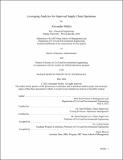| dc.contributor.advisor | Willems, Sean | |
| dc.contributor.advisor | Simchi-Levi, David | |
| dc.contributor.author | Muller, Alexander | |
| dc.date.accessioned | 2022-11-30T19:40:30Z | |
| dc.date.available | 2022-11-30T19:40:30Z | |
| dc.date.issued | 2022-05 | |
| dc.date.submitted | 2022-08-25T19:15:39.287Z | |
| dc.identifier.uri | https://hdl.handle.net/1721.1/146673 | |
| dc.description.abstract | Decision making under ambiguity is a central challenge for supply chain organizations. Key obstacles to optimal decisions include insufficient data, opaque and complex processes, and uncertainty about the future. Traditionally, organizations have relied upon internal heuristics and “gut feels” to make decisions with mixed results. This work demonstrates how simple models can be leveraged to provide clarity at operational and strategic levels. Specifically, this work focuses on the development and implementation of models at two American Industrial Partners (AIP) portfolio companies: Commonwealth Rolled Products (CRP) and AHF Products (AHF).
CRP is an aluminum rolling mill that produces both common alloy (CA) and automotive body sheet (ABS) aluminum products. The organization has struggled with managing high ingot inventory levels that have led to high holding costs and order delinquency. This work demonstrates how applications of simple flow improvements, the base stock model, and capacity analytics were used to reduce ABS delinquencies by 34%, eliminate ~$13M in stagnant inventories, and scope a strategic expansion with a net present value (NPV) of ~$10M.
AHF is a flooring company that faces a strategic challenge in forecasting the price of its core raw material. There is no currently available commercial forecast, so the procurement team relies on consensus guesses that have been consistently inaccurate. This work builds a novel pricing model that combines linear regression and time series analysis to develop a robust tool that has predicted within 1% of actual prices after four months. This model has been deployed to improve the budgeting and pricing strategy of the company.
We will present in more detail the operational challenges faced by the supply chain organizations of CRP and AHF. Following this discussion, we will examine the model formulations and analytical techniques used to address these problems. Next, we will detail the pragmatic choices needed to create sustainable models that can be maintained by the organization. Finally, we will discuss the results of these models at the respective companies and their future extensions. | |
| dc.publisher | Massachusetts Institute of Technology | |
| dc.rights | In Copyright - Educational Use Permitted | |
| dc.rights | Copyright retained by author(s) | |
| dc.rights.uri | https://rightsstatements.org/page/InC-EDU/1.0/ | |
| dc.title | Leveraging Analytics for Improved Supply Chain Operations | |
| dc.type | Thesis | |
| dc.description.degree | M.B.A. | |
| dc.description.degree | S.M. | |
| dc.contributor.department | Sloan School of Management | |
| dc.contributor.department | Massachusetts Institute of Technology. Department of Civil and Environmental Engineering | |
| dc.identifier.orcid | 0000-0001-6384-9720 | |
| mit.thesis.degree | Master | |
| thesis.degree.name | Master of Business Administration | |
| thesis.degree.name | Master of Science in Civil and Environmental Engineering | |
